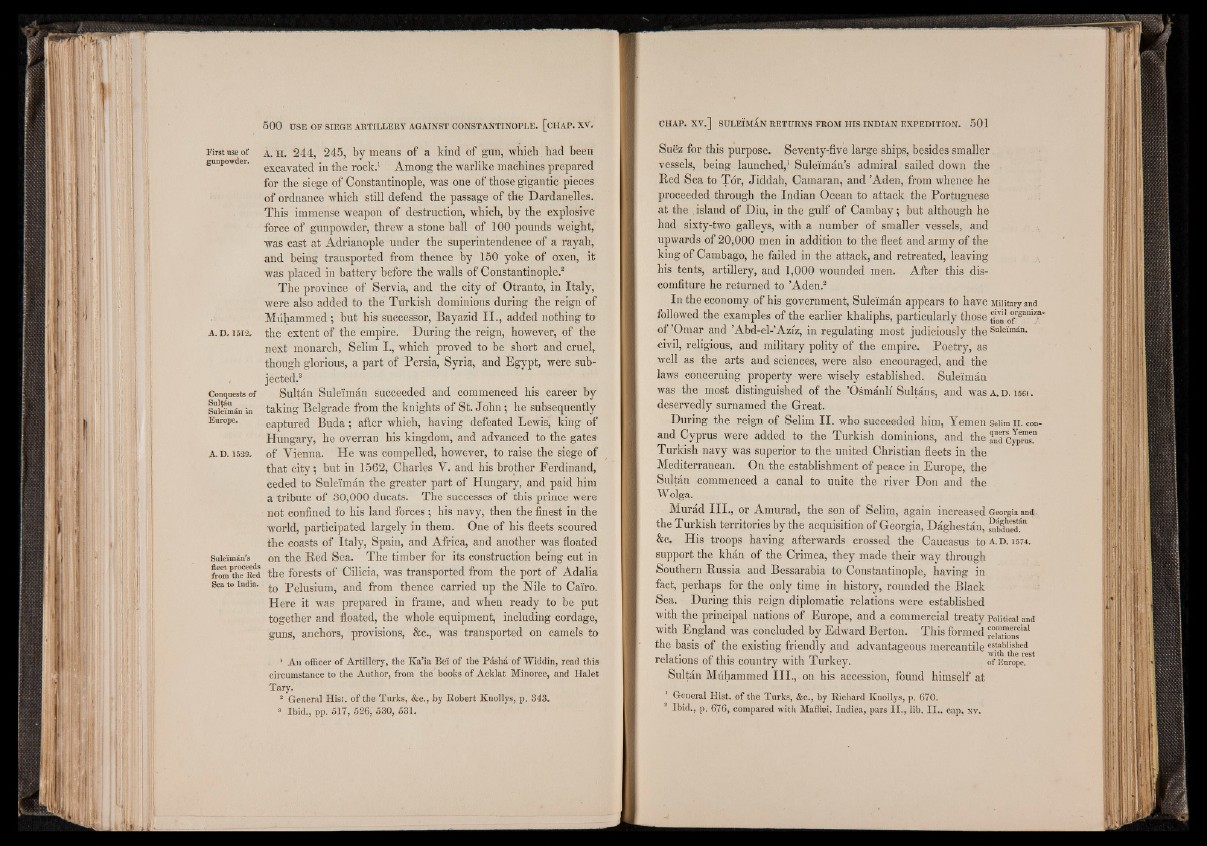
First use of
gunpowder.
A. D , 1512,
Conquests of
Sultán
Suleïmàn in
Europe.
A .D . 1529,
Suleiman’s
fleet proceeds
from the Bed
Sea to India.
A. h . 244, 245, by means of a kind of gun, which had been
excavated in the rock.1 Among the warlike machines prepared
for the siege of Constantinople, was one of those gigantic pieces
of ordnance which still defend the passage of the Dardanelles.
This immense weapon of destruction, which, by the explosive
force of gunpowder, threw a stone ball of 100 pounds weight,
was cast at Adrianople under the superintendence of a rayah,
and being transported from thence by 150 yoke of oxen, it
was placed in battery before the walls of Constantinople.8
The province of Servia, and the city of Otranto, in Italy,
were also added to the Turkish dominions during the reign of
Muhammed; but his successor, Bayazid II., added nothing to
the extent of the empire. During the reign, however, of the
next monarch, Selim I., which proved to be short and cruel,
though glorious, a part of Persia, Syria, and Egypt, were subjected,
3
Sultan Suleiman succeeded and commenced his career by
taking Belgrade from the knights of St. John; he subsequently
captured Buda; after which, having defeated Lewis, king of
Hungary, he overran his kingdom, and advanced to the gates
of Vienna. He was compelled, however, to raise the siege of
that city, but in 1562, Charles V. and his brother Ferdinand,
ceded to Suleiman the greater part of Hungary, and paid him
a tribute of 30,000 ducats. The successes of this prince were
not confined to his land forces ; his navy, then the finest in the
world, participated largely in them. One of his fleets scoured
the coasts of Italy, Spain, and Africa, and another was floated
on the Bed Sea. The timber for its construction being cut in
the forests of Cilicia, was transported from the port of Adalia
to Pelusium, and from thence carried up the Nile to Cairo.
Here it was- prepared in frame, and when ready to be put
together and floated, the whole equipment, including cordage,
guns, anchors, provisions, &c., was transported on camels to
1 Ail officer of Artillery, the Ka’ia Be! of the Pasha of Widdin, read this
circumstance to the Author, from the books of Acklat Minoree, and Halet
Tary.
8 General Hist, of the Turks, &c., by Robert Knollys, p. 343.
9 Ibid., pp. 517, 526, 530, 531.
Suez for this purpose. Seventy-five large ships, besides smaller
vessels, being launched,1 Sulei'mán’s admiral sailed down the .
Bed Sea to Tor, Jiddah, Camaran, and ’Aden, from whence he
proceeded through the Indian Ocean to attack the Portuguese
at the , island of Diu, in the gulf of Cambay; but although he
had sixty-two galleys, with a number of smaller vessels, and
upwards of 20,000 men in addition to the fleet and army of the
king of Cambago, he failed in the attack, and retreated, leaving
his tents, artillery, and 1,000 wounded men. After this discomfiture
he returned to ’Aden.2
In the economy of his government, Sule'ímán appears to have Military and
followed the examples of the earlier khaliphs, particularly those
of ’Omar and ’Abd-el-’Aziz, in regulating most judiciously the Suieimán.
civil, religious, and military polity of the empire. Poetry, as
well as the arts and sciences, were also encouraged, and the
laws concerning property were wisely established. Suieimán
was the most distinguished of the ’Osmánlí Sultáns, and was a . d . i 56t .
deservedly surnamed the Great.
During the reign of Selim II. who succeeded him, Yemen Selim n. con-
and Cyprus were added to the Turkish dominions, and the S'cjp™“
Turkish navy was superior to the united Christian fleets in the
Mediterranean. On the establishment of peace in Europe, the
Sultán commenced a canal to unite the river Don and the
Wolga.
Murád III., or Amurad, the son of Selim, again increased Georgia and.
the Turkish territories by the acquisition of Georgia, Dághestán, Sbdueí“
&c. His troops having afterwards crossed the Caucasus to a . d . 15 7 4 .
support the khán of the Crimea, they made their way through
Southern Bussia and Bessarabia to Constantinople, having in
fact, perhaps for the only time in history, rounded the Black
Sea. During this reign diplomatic relations were established
with the principal nations of Europe, and a commercial treaty Political and
with England was concluded by Edward Berton. This formed “¡”t?ons°lal
the basis of the existing friendly and advantageous mercantile es.tablished
relations of this country with Turkey. of Earope.eSt
Sultán Múhammed III., on his accession, found himself at
1 General Hist, of the Turks, &c., by Richard Knollys, p. 670.
2 Ibid., p. 676, compared with Maffaei, Indica, pars I I . , lib. I I .. cap, xv.